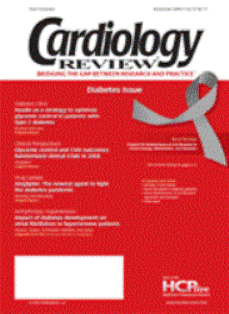Publication
Article
Cardiology Review® Online
Diabetes mellitus and atrial fibrillation: Upstream treatment mitigates downstream complications
The incidence of atrial fibrillation (AF), which is the most frequently encountered sustained cardiac arrhythmia, is increasing in the United States.
The incidence of atrial fibrillation (AF), which is the most frequently encountered sustained cardiac arrhythmia, is increasing in the United States.1 Numerous risk factors have been implicated in the development of AF, including nonmodifiable risk factors such as age and the patient’s sex, modifiable risk factors such as obesity and smoking history, and disease-specific risk factors such as hypertension, diabetes, heart failure, coronary and valvular heart disease (particularly mitral regurgitation), and thyroid disease.2-5 Because AF and diabetes mellitus have reached epidemic levels worldwide, it is particularly important to examine the relationship between these entities.
The VALUE (Valsartan Antihypertensive Long-term Use Evaluation) trial compared the effect of the angiotensin-II receptor blocker valsartan with the calcium-channel blocker amlodipine on cardiac mortality.6 In this study, a total of 15,245 patients from 31 nations were followed for 4.2 years until a prespecified number of patients (n = 1450) had a primary cardiac event.7 New-onset AF (as assessed by an annual electrocardiogram [ECG]) was a prespecified secondary outcome. Aksnes and colleagues provide a post hoc analysis of this trial and examine the relationship between the development of diabetes mellitus and new-onset AF.8 They found that patients with new-onset diabetes mellitus were significantly more likely (hazard ratio [HR], 1.49) to develop AF than those without diabetes; new-onset diabetes was defined as evidenced by study investigators, included those who used antidiabetic drugs during the trial, and those who had a fasting glucose concentration of 7 mmol/L (126 mg/dL) or above in a blood sample at the end of the trial. The most significant finding was that the development of AF translated into a significantly greater risk of developing heart failure (HR, 3.56) and stroke (HR, 1.96).
Would “upstream” treatment of high-risk patients mitigate adverse outcomes?
It is apparent that in hypertensive patients, manipulation of the renin-angiotensin-aldosterone system using either angiotensin-converting enzyme inhibitors or angiotensin receptor blockers (ARBs) can make a difference.9,10 One particularly important benefit is the reduction in the risk of developing de novo AF, particularly with ARBs.11 For example, the LIFE (Losartan Intervention for End Point Reduction in Hypertension) study evaluated 9193 patients aged 55 years to 80 years with treated or untreated hypertension and compared the effect of an ARB (losartan) with a beta blocker (atenolol) on an end point of cardiovascular morbidity (myocardial infarction and stroke) and mortality.12 Both groups showed a similar reduction in blood pressure. Of the 8851 patients without AF at baseline, new-onset AF occurred in 150 patients receiving losartan versus 221 patients receiving atenolol after at least 4 years of follow-up, representing a 33% reduction in the risk of developing AF in patients treated with losartan. Similar findings were observed in the VALUE trial, where the incidence of new-onset AF (paroxysmal and persistent) was 16% lower in the valsartan arm (3.67% vs 4.34% in the amlodipine arm; P = .044).6
Where do we go from here?
First, future trials need to do a better job of screening for AF. Studies to date have relied on annual ECGs, which clearly underestimate the true burden of AF, especially in patients with paroxysmal AF. Second, in addition to using ARBs in hypertensive patients, those at high risk for developing diabetes mellitus need to be counseled on the protective effects of exercise, weight loss, smoking cessation, and lipid-lowering therapies (fish oils and statins) on the development of AF. Only by taking a multifactorial approach can we hope to reduce the burden of AF and its “downstream” complications like heart failure, stroke, and death.






